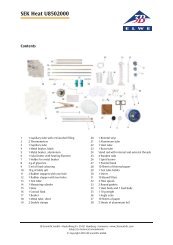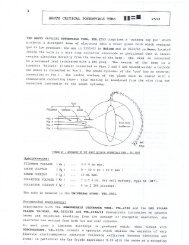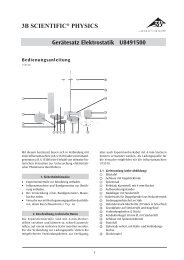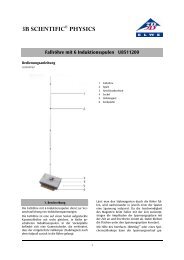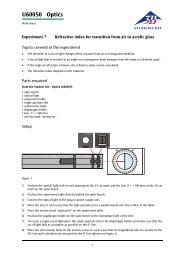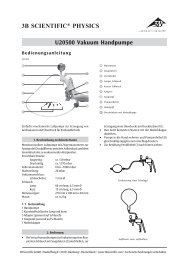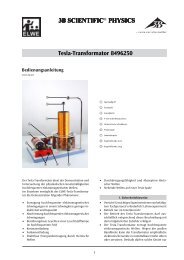3B SCIENTIFIC PHYSICS ELEKTROCHEMIE U11110 ...
3B SCIENTIFIC PHYSICS ELEKTROCHEMIE U11110 ...
3B SCIENTIFIC PHYSICS ELEKTROCHEMIE U11110 ...
Create successful ePaper yourself
Turn your PDF publications into a flip-book with our unique Google optimized e-Paper software.
Experiment 6 - Measuring voltage Teacher's instructions<br />
Measuring the standard electrochemical potentials of various non-metals<br />
Chemicals Hazard<br />
symbols<br />
R phrases S phrases Equipment<br />
Meter<br />
Sodium chloride ---<br />
--- Electrodes:<br />
2 C, 1 Pt gauze<br />
Potassium bromide --- --- 2 Experiment cables<br />
Sodium iodide --- --- 1 Mains power supply<br />
Hydrochloric acid 1 mol/l<br />
36/37/38 26 2 Pipettes<br />
Distilled water --- --- 1 3V adapter<br />
Warning: Please take care: Hydrochloric acid is corrosive!<br />
Experiment procedure:<br />
1. The prepared 1.0 molar electrolyte solutions should be given to the students. Students require no more than 10 ml of<br />
the relevant solution each.<br />
2. Assemble the battery block as described.<br />
3. Add the 1 molar hydrochloric acid to one chamber of the battery block using the pipette and insert the platinum<br />
gauze electrode into this cell.<br />
4. Add a 1 molar NaCl solution to a second chamber (opposite the platinum gauze electrode) and insert a carbon<br />
electrode.<br />
5. To form a normalized hydrogen electrode, a 3V adapter is connected to the power supply. Connect the negative<br />
pole of the 3V adapter to the platinum gauze electrode and the positive pole to the carbon electrode using<br />
experiment cables. Connect the power supply to the 230 V mains and electrolyze the platinum gauze for about 30<br />
seconds. Hydrogen forms at the platinum gauze and completely surrounds the gauze.<br />
6. The 3V adapter is then replaced by the meter and the Cl - / Cl2 voltage can then be read off.<br />
7. Proceed as in steps 4 to 6 with each of the other non metals dipping the carbon electrode into potassium bromide<br />
and potassium iodide solutions one after the other to determine the electrochemical potentials of Br - / Br2 and I - / I2 .<br />
Observation and evaluation:<br />
C C C<br />
Pt _ connection<br />
(3) (2) (1)<br />
For each redox pair, the standard electrochemical potentials as measured should be:<br />
(1) Cl - / Cl2 = + 1.35 V, (2) Br - / Br2 = + 1.06 V, (3) I - / I2 = + 0.54 V<br />
Calculation of masses required to prepare 1 liter of a 1 molar solution:<br />
1. For an NaCl solution 58.44 g of NaCl is needed.<br />
2. For a KBr solution 119.01 g of KBr is needed.<br />
3. For a KI solution 166.00 g of KI is needed.<br />
18<br />
3V adapter<br />
+ 230V



